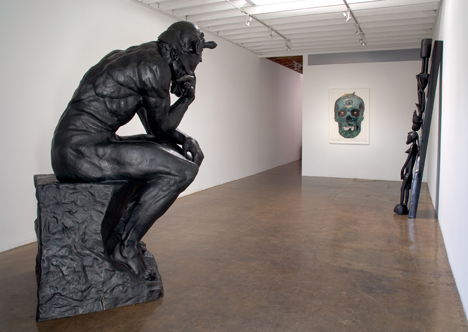
Installation shot of Nathan Mabry exhibition at Cherry and Martin Gallery, 2008. Courtesy the gallery.
A friend of mine dated a composer once. He was a good composer. People found his music “inventive” and “ubiquitous” (in a good way). All of his friends were musicians, artists, or filmmakers and they seemed to be good at what they did too—they cared about craft and they promoted themselves and each other well enough to ensure that a like-minded posse would always be around when they debuted new work. At first, this scenario seemed perfect: having a composer boyfriend with creative friends who made things all the time. But my friend soon noticed that none of these people showed much interest in the meaning of what they were making. She would go to openings at which the art on exhibit looked unambitious, sometimes exploitative or hackneyed, but criticism, even veiled skepticism, was unthinkable. This was a loyal tribe. If you were in, you were in, no matter how brilliant or lifeless your work might be.
Only once did a member of the tribe—an indie rocker from a band-you’ve-definitely-heard-of—get axed. He slept with a girl he shouldn’t have slept with, and, after that, his cohorts weren’t his cohorts anymore. My friend understood why the rocker’s behavior would be reprehensible, but she wondered why his music, a heavy-handed brand of emo that turned human experience into a spurt of blind antagonisms, hadn’t played even a small part in his excommunication. How could a group of artists so effortlessly separate the code they lived by from the art they made?
“You’re not really supposed to discuss moral and ethical matters around contemporary art,” wrote Ben Street, a month into the Must Art Be Ethical? debate. “Express discomfort at Sierra’s synagogue or Fraser’s fornication . . . and your contemporary art membership card is permanently revoked.” This, Street suggested, is a measure of contemporary art’s insecurity with itself. Such insecurity could come from numerous sources, many of which played out during the ethics discussion we’ve had on this site these past few months: modernism, money, representation (also here), quantity, institutional policies, power, education, art world politics (and here), artistic process, and the definition of what artists even are.
William Powhida, "How The New Museum Committed Suicide with Banality," 2009. Courtesy Schroeder Romero+Shredder and the Artist.
“Artists are an educated class of cultural producers who routinely challenge ‘moral authority’ and share a tolerance for minority perspectives,” wrote artist William Powhida in his March 18 post. But, as Jennifer Dalton, who co-curated the recent #class exhibition with Powhida, pointed out, “The art world is not such a tolerant place.” She continued, “We don’t like conservatives, even socially-liberal-fiscally-conservative ones . . . . Our commitment to free expression is limited to the types of ‘transgressions’ we are all entirely comfortable with.”
Laura Fried‘s recent post discussed one transgression with which we’ve become comfortable: institutional critique. “The great weakness of institutional critique,” she said, “was its failure to move beyond the exposure of unethical (or questionable) institutional practices in favor of affecting real change.” Fried points to Carey Young as an example of an artist who activates her audiences with change in mind. Of course, believing that art can affect real change requires admitting that something should change, and admitting that something should change requires taking an ethical stand on both life and art.
Carey Young, "Speech Acts," 2009. Installation view at Contemporary Art Museum St Louis. Photo: David Ulmer.
It’s hard to talk about art as ethical or unethical. It’s often easier to critique the ethics of the art world. Wrote Ben Street:
The conflation of object and its receptive context make ethical discussions about art really ethical discussions about how the art world behaves. This is like blaming money itself for the financial crisis. . . . I want to address the question in the way I first interpreted it: can there be anything ethical about art itself, or is it perpetually at one remove from the conversation? Can art itself be, now, a proposal about how to live?
Poet Ariana Reines once said she writes because she’s interested in living her life. Poetry acted metonymically, like a living stand-in. Good art, Ed Winkleman pointed out, is neither ethical nor unethical. It’s just good. But if we really take it seriously, it affects the way way we understand life and, if it affects the way understand life, then it affects the way we understand ethics and it affects the way we live.